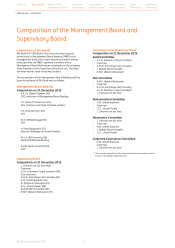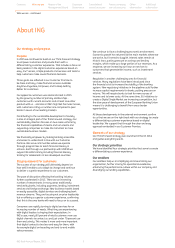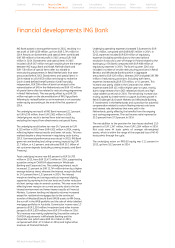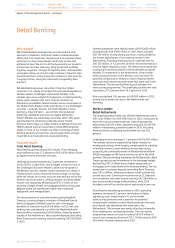ING Direct 2015 Annual Report Download - page 15
Download and view the complete annual report
Please find page 15 of the 2015 ING Direct annual report below. You can navigate through the pages in the report by either clicking on the pages listed below, or by using the keyword search tool below to find specific information within the annual report.
Contents
Who we are
Report of the
Management
Board
Corporate
Governance
Consolidated
annual accounts
Parent company
annual accounts
Other
information
Additional
information
Report of the Management Board - continued
Progress on regulatory initiatives that are most
relevant
November 2014 marked the start of the Single
Supervisory Mechanism (SSM), with a central role for the
ECB in the prudential supervision of eurozone banks. This
was a decisive moment in the creation of the European
Banking Union.
ING Bank has always been a strong supporter of the SSM. As a
predominantly European cross-border universal bank, we
have a clear interest in the proper functioning of European
financial markets and in a harmonised approach to European
supervision. We believe that it will contribute to a more
efficient use of financial funds across Europe and as such
should help to foster the growth prospects of the European
economy.
After the first full year of operating under the new supervisory
framework, banks’ experiences are generally
positive. The SSM aims to create the institutional conditions
for overcoming fragmentation in supervisory practices. It is
important that common methodologies and a shared culture
are created within the SSM. That takes time. Some banks may
experience challenges in the short term as they come to
terms with the SSM supervisory approach. We expect that the
SSM will increase its transparency as the system gets
embedded.
As well as the SSM, 2015 saw preparations for the Single
Resolution Mechanism (SRM). The SRM came into force
on 1 January 2016. This aims to ensure an orderly resolution
process for failing banks.
With SSM and SRM, two of the three pillars of Banking Union
have been established. The final pillar, mutualisation of
deposit guarantee schemes is the last remaining pillar, which
is progressing at a much slower pace. Lack of a common
European deposit guarantee scheme leaves the eurozone
potentially vulnerable to bank-sovereign interdependency,
despite the existence of the SSM. For national sovereigns
remain, explicitly or implicitly, a liquidity provider of last resort
for the deposit insurance scheme. When sovereigns get into
trouble, deposit holders will worry that the national DGS will
be unable to meet its commitments should domestic banks
fail. Greece’s experience in 2015 made this clear. Capital
controls had to be imposed to contain a bank
run, and a euro deposited at a Greek bank was no longer
de facto equal to a euro deposited at a bank in another
member state.
Payment Services Directive (PSD II)
The second EU Directive on Payment Services (PSD
II) was adopted in October 2015. This aims to create
an EU-wide single market for payments with a modern and
comprehensive set of rules. The goal is to make cross-border
payments as easy, efficient and secure as domestic
payments within a member state. The PSD II also seeks to
improve competition by opening up payment markets to new
entrants, thus fostering greater efficiency and cost-reduction.
While implementation in national law could take several
years, ING sees the PSD II as an opportunity to develop new
ways of serving our customers.
Regulatory uncertainty
The large number of new regulatory initiatives and
consultations concerning banks’ capitalisation continued to be
a source of uncertainty in 2015. Examples are the ongoing
discussions on bail-in-able instruments (MREL/TLAC), but also
discussions in the Basel Committee about the risk weighting
methodology and the interest rate risk in the banking book.
Our main concern is that there is insufficient overview of the
combined impact of all initiatives. Moreover, it is unclear what
regulatory end-state policymakers are aiming for. This
regulatory uncertainty complicates multi-year strategic
planning and pushes banks towards confining themselves to
no-regret decisions. Also considering the competitive
pressures and fast market developments outlined below, we
believe this piecemeal approach to regulation is not in the
best interest of banks and their stakeholders.
In addition to more traditional financial-sector regulation, we
notice increasing regulatory interest in environmental and
human rights impacts associated with our business activities.
The International CSR Covenant process initiated by the Dutch
Government, and in which ING actively participates, builds on
the OECD Guidelines for Multinational Enterprises. There is a
call on the part of the public for increased transparency and
continuous debate on the matter in the EU Parliament.
Regulators are also looking at the potential link between
sustainability and financial risk. An example is the Financial
Stability Board looking into potential financial risks of climate
change regulation.
Regulatory context
ING Bank Annual Report 2015 13
























